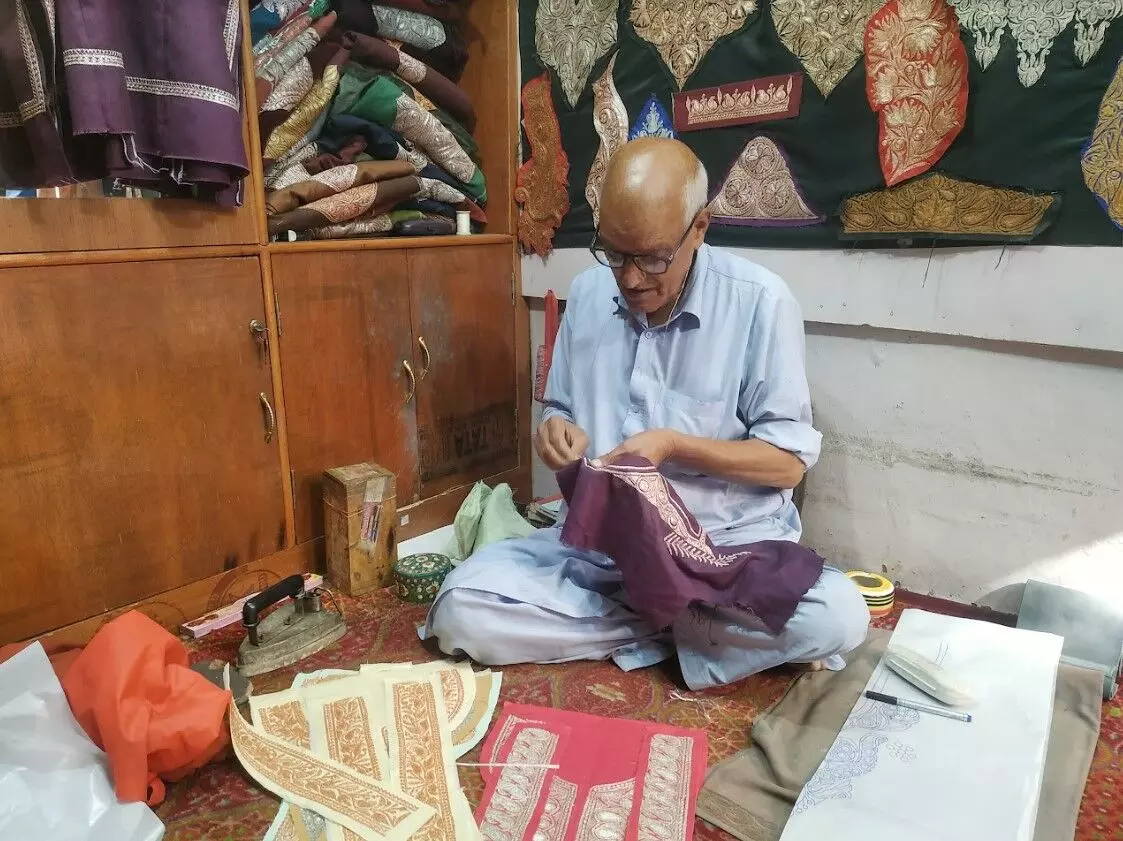The Artisan's Blurring Vision
Four in ten Kashmiri artisans say that their intricate work weakens their eyesight
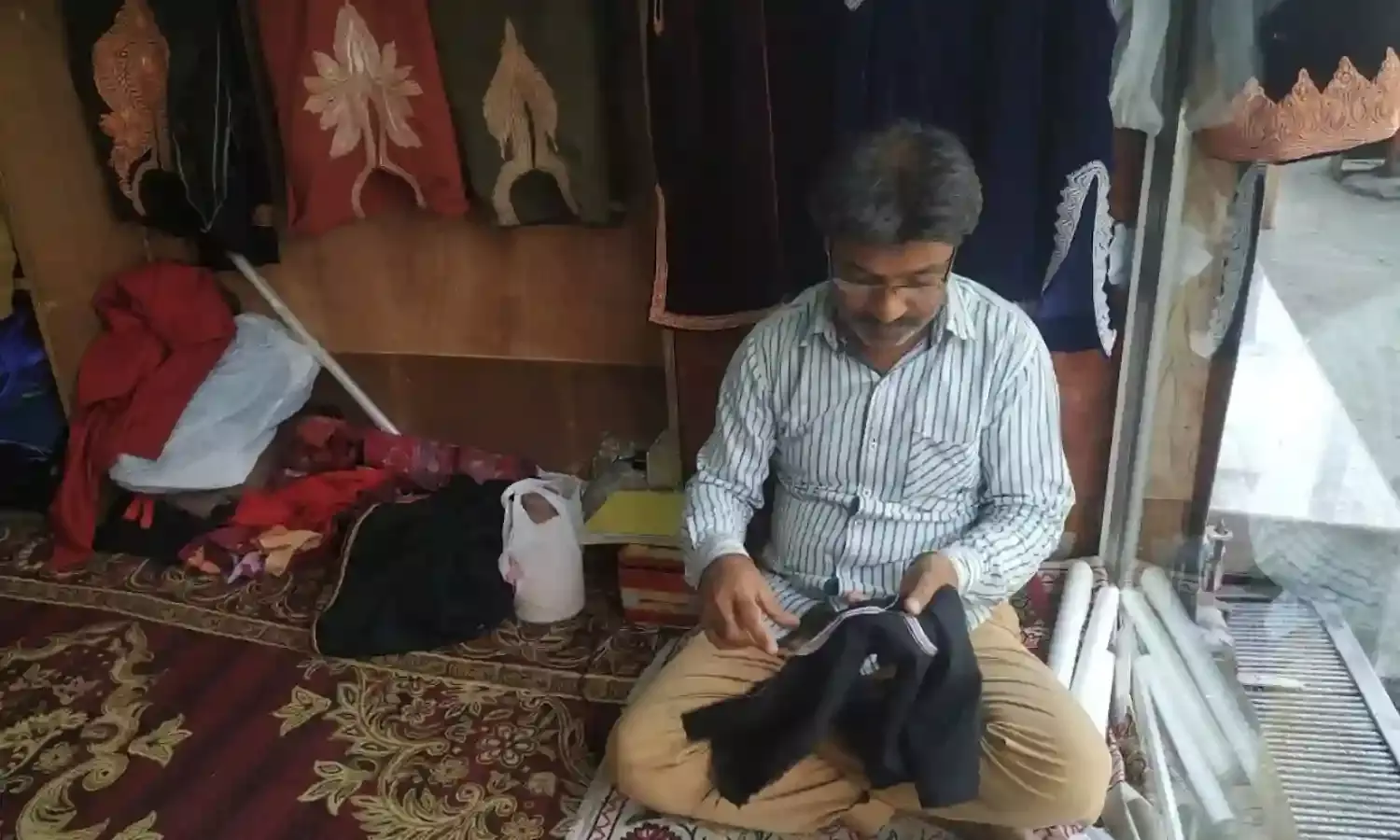
Abdul Rashid embroiders beautiful patterns on woolen pherans with his tiny needle and gold-silver threads. His daily devotion to his craft reflects on his wizened face, his quirkiness and captive conversations on life and times in Kashmir endear him to all who meet him.
This septuagenarian artisan has spent 55 years of his life practising the needlework craft, and still feels strongly about continuing it despite his advancing years. However, his blurry vision is playing a spoilsport, for the first time in his illustrious career.
Rashid adjusts his glasses before he begins working on his next masterpiece. Without the magnified vision, the intricate patterns on the cloth seem to lose their shape and form. Many of his fellow craftsmen are in the same boat.
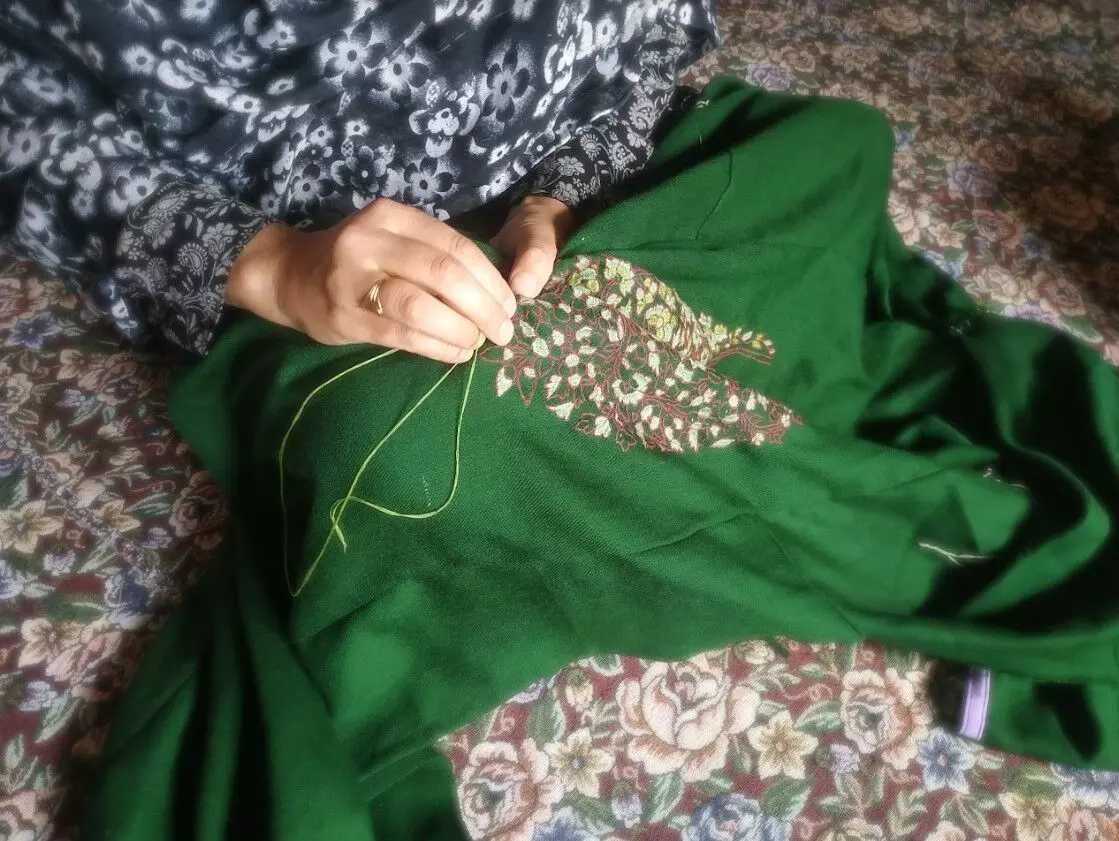
The community of craftspersons is grappling with both financial difficulties and increasing eye ailments. The crafts people say their weakening vision is now threatening Kashmir's globally celebrated craft.
In November 2021, the United Nations Educational, Scientific and Cultural Organization (UNESCO) 'adopted' Rashid's hometown, Srinagar, "as part of the creative city network under the Crafts and Folk Arts category". Kashmir's summer capital earned this distinction as it's considered a cradle of Kashmir crafts.
"Kashmiri handicrafts require a lot of care and time to complete," said Rashid even as he continued working, "it's a particularly challenging task that can also result in various eye illnesses."
Since Kashmir's famous embroidery known as 'tilla' takes months to complete, many artists say they experience eye discomfort and even blurry vision. "Hand embroidered tilla takes much more time than machine tilla," said Rashid continued, "manual needle work demands a full day of work, which causes muscle cramps and blurry vision."
Hand tilla's reflective nature also strains the artisan's eye on the bright daylight. Rashid has to wear a neck-collar, a back support belt and eyeglasses when he works.
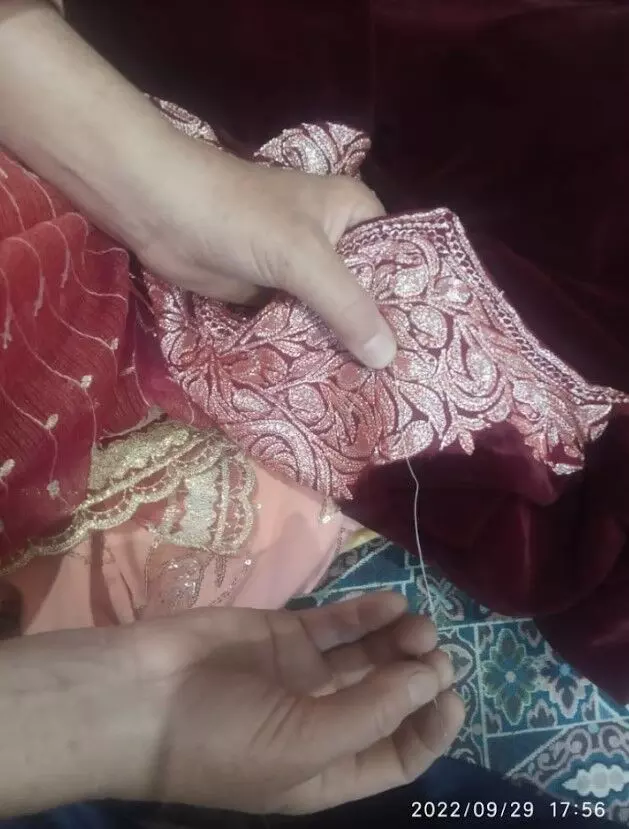
Like Rashid, Fareeda Mehraj has been making Kashmiri crafts for the past 25 years. She works from home, and toils everyday to give her children a better education, and secure their life. But now, the mother of two says she is losing her eyesight fast. Even the thick magnifying glasses aren't helping anymore. "My eyesight has weakened a lot over the years, and apart from neck and back pain, my fingers also hurt due to continuous needle pricks now," shs said.
While some artisans suffer in silence within the walls of their home, there are others who are suffering right under the gaze of the community. For years, Mohammad Sultan has been a go-to-artisan for hundreds of clients. He is particularly sought after by brides who adore the pherans embellished by his handmade needlework patterns.
"I gave four-decades of my life to this craft, and am still passionate about my work," said Sultan, a bespectacled artisan who keeps his head low focusing on the needlepoint. "But now, my eyes have problems and it is difficult for me to focus on my work."
If Sultan is facing a crisis due to his failing vision, then Afshan, a young Souzni worker, grapples with the darkness inside her room in Srinagar. In her late twenties, the skinny girl is working on a pheran adjusting her thick glasses. "Compared to the daily demands, the earnings we make are quite low. We're unable to provide for our family members' basic necessities, including clothing, healthcare and educational opportunities," she said
Craftwork like souzni, tilla, aariis are both intellectually and physically draining, said Afshan. "We spend a lot of time alone in a room because of the nature of our work, and are unable to travel as freely as others. We work all day long, yet we're unable to cover our bills and end up with blurred vision. Our eyes have become weak. I'm trying to avoid doing this work because my eyes are getting weaker and weaker. I have to wear glasses," she said.
Footfalls at eye clinics are growing in Kashmir. In Dr. Sajjad Hussain Qanungo's well-known eye-clinic, the patient-load is mostly from the handicrafts sector, and is rising. According to the doctor, a number of artists come with complaints of headaches, blurred vision, muscular spasms and dry eyes.
"These artisans put a lot of strain and pressure on their eyes by working up close, for extended periods of time," said Dr. Qanungo. Strong near-vision, the doctor said, is necessary for persons who work with crafts like knitting or weaving.
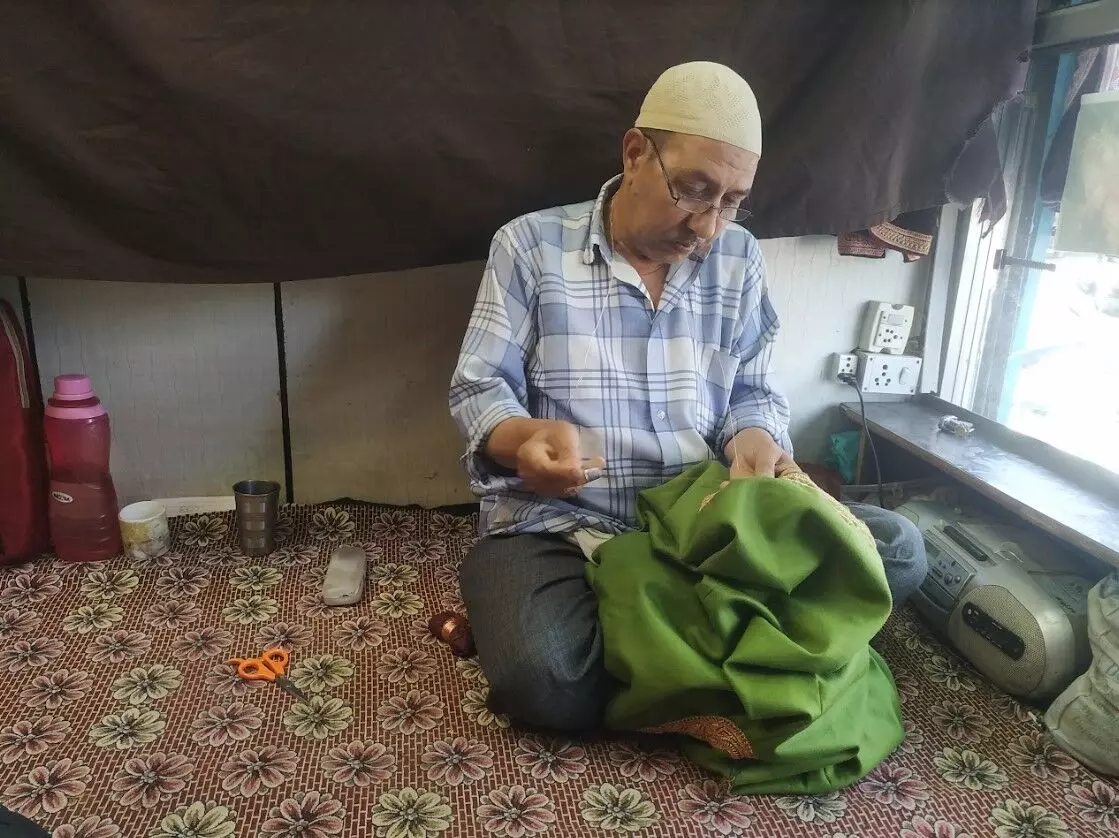
"When a person is younger than 40, their lenses are still healthy and clear, but if they work closely, for an extended period of time, their convex lenses weaken and they need to wear glasses to see close-up objects more clearly," the eye specialist said.
This crisis is clearly harming Kashmir's arts and crafts. Many artisan have already left the vocation to seek some other means of earning a living. Those who continue say they are doing it for the sake of 'loyalty' and their 'lifelong association' with the crafts.
Abdul Qayoom Najar was barely 12 years old when he started as a tilla worker. At 33 years of age now, he has come of age as an artisan. "My tribe is leaving this craft as they're losing vision," said Najar, knitting a black cloth with silver tilla thread in his old city store. "But I can't leave this. I was a math topper in my school, but had to leave my studies to support my family. There's no question of walking away from this despite these thick glasses on my weak eyes now," he said.
In the craft bazaar of Srinagar's Khanqah Moullah, sexagenarian Gulzar Ahmad is sitting inside an art store decorated with pherans. "When I was younger, I finish a pheran in 10 to 15 days, but now it takes me at least two months to finish one due to eye problems," he said adding "the younger generation isn't showing any interest in learning this skill as they are aware how much we suffer and don't want to experience the same for themselves."
As of now, said ophthalmologist Dr T P Singh, there's no study highlighting the eyesight crisis faced by Kashmiri craftspeople. "However, a lot of artisans come for checkup after 45 years of age when they develop an eye-condition called presbyopia and need glasses for close up work," said Dr Singh.
"Artisans should be able to thread a needle, but many tilla-artisans or carpet-weavers come with complaints of eye fatigue. So, we provide them with near correction glasses. We can't tell them to change their line of work because that wouldn't be realistic, but I do recommend a routine eye exam after every four to six months," he added.
However, artisans like Rashid termed the treatment as "unrealistic" and unaffordable for the struggling artisans. "Doctors put us [artisans] on a vitamin A diet and supplements, but they fail to diagnose the distress we artisans face due to dearth of work. Our struggle for skill and survival ends up blurring our lives and legacy," he said.
